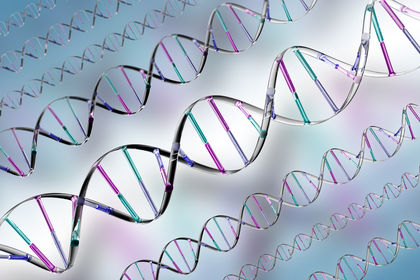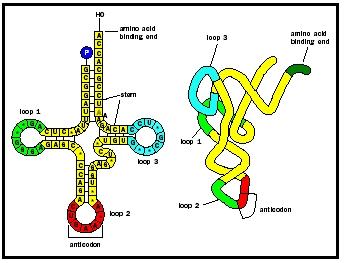Transfer RNA

During protein synthesis at the ribosome , the nucleic acid sequence of deoxyribonucleic acid (DNA) and ribonucleic acid (RNA) is translated into the amino acid sequence of a protein. Transfer RNA (tRNA) is an important adapter that "reads" the nucleic acid code in the messenger RNA (mRNA) and "writes" an amino acid sequence. Transfer RNAs transfer individual amino acids onto the growing polypeptide chain.
There is at least one tRNA for each of the twenty naturally occurring amino acids. Each tRNA is transcribed from a different gene but the tRNA genes are clustered in the genome of some organisms. These clusters of genes are transcribed as a single unit, which results in the production of one large precursor RNA molecule. Individual tRNAs are then enzymatically separated from one another. Each tRNA is distinguished by a particular three-nucleotide sequence (the "anticodon") in one region, and by its ability to link up with a particular amino acid.
The nucleotide sequence of the first tRNA was determined in 1965. As of 2000, there are more than one hundred tRNA sequences known, and they are all quite similar. All tRNA molecules are relatively short, composed of less than one hundred nucleotides. Unlike those found in DNA and mRNA, many of the nucleotides found in tRNA are modified to enhance their interactions. Although the three-dimensional shape of tRNA molecules has traditionally been depicted as a cloverleaf, X-ray crystallographic methods have revealed that the actual shape of a tRNA is an upside down letter L.
During protein synthesis, the anticodon at one end of the L interacts with a triplet nucleotide in the mRNA called a codon . The correct tRNA will form "Watson-Crick"–type base pairs between the triplet anticodon

At the other end of the L is the amino acid binding site. Enzymes (called aminoacyl tRNA synthetases) join the proper amino acid to its corresponding tRNA. This reaction requires ATP and the bond generated is a "high-energy" (that is, weak) bond. During the addition of the amino acid to the growing polypeptide, this bond is easily hydrolyzed , releasing the energy needed to power the process.
SEE ALSO Protein Synthesis ; Ribosome ; RNA
James E. Blankenship
Bibliography
Alberts, Bruce, et al. Molecular Biology of the Cell, 4th ed. New York: Garland Publishing, 2000.
Stryer, Lubert. Biochemistry, 4th ed. New York: W. H. Freeman and Company, 1995.
Comment about this article, ask questions, or add new information about this topic: